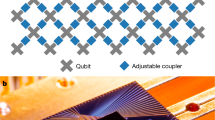Abstract
Quantum computers1,2,3,4,5 can in principle exploit quantum-mechanical effects to perform computations (such as factoring large numbers or searching an unsorted database) more rapidly than classical computers1,2,6,7,8. But noise, loss of coherence, and manufacturing problems make constructing large-scale quantum computers difficult9,10,11,12,13. Although ion traps and optical cavities offer promising experimental approaches14,15, no quantum algorithm has yet been implemented with these systems. Here we report the experimental realization of a quantum algorithm using a bulk nuclear magnetic resonance technique16,17,18, in which the nuclear spins act as ‘quantum bits’19. The nuclear spins are particularly suited to this role because of their natural isolation from the environment. Our simple quantum computer solves a purely mathematical problem in fewer steps than is possible classically, requiring fewer ‘function calls’ than a classical computer to determine the global properties of an unknown function.
This is a preview of subscription content, access via your institution
Access options
Subscribe to this journal
Receive 51 print issues and online access
$199.00 per year
only $3.90 per issue
Buy this article
- Purchase on Springer Link
- Instant access to full article PDF
Prices may be subject to local taxes which are calculated during checkout



Similar content being viewed by others
References
Deutsch, D. Quantum theory, the Church-Turing principle and the universal quantum computer. Proc. R. Soc. Lond. A 400, 97–117 (1985).
Shor, P. Algorithms for quantum computation: discrete logarithms and factoring. Proc. 35th Annu. Symp. on Found. of Computer Science 124–134 (IEEE Comp. Soc. Press, Los Alomitos, CA, 1994).
Divincenzo, D. P. Quantum computation. Science 270, 255–261 (1995).
Lloyd, S. Quantum-mechanical computers. Sci. Am. 273, 44–50 (1995).
Ekert, A. & Jozsa, R. Quantum computation and Shor's factoring algorithm. Rev. Mod. Phys. 68, 733–753 (1996).
Deutsch, D. & Jozsa, R. Rapid solution of problems by quantum computation. Proc. R. Soc. Lond. A 439, 553–558 (1992).
Simon, D. On the power of quantum computation. Proc. 35th Annu. Symp. on Found. of Computer Science 116–124 (IEEE Comp. Soc. Press, Los Alamitos, CA, 1994).
Grover, L. K. Quantum computers can search arbitrarily large databases by a single query. Phys. Rev. Lett. 79, 4709–4012 (1997).
Unruh, W. G. Maintaining coherence in quantum computers. Phys. Rev. A 51, 2, 992–997 (1995).
Chuang, I. L., Laflamme, R., Shor, P. & Zurek, W. H. Quantum computers, factoring, and decoherence. Science 270, 1633–1635 (1995).
Landauer, R. Dissipation and noise immunity in computation and communication. Nature 335, 779–784 (1988).
Landauer, R. Is quantum mechanics useful? Phil. Trans. R. Soc. Lond. A 335, 367–376 (1995).
Palma, G. M., Suominen, K.-A. & Ekert, A. K. Quantum computers and dissipation. Proc. R. Soc. Lond A 452, 567–584 (1996).
Monroe, C., Meekhof, D. M., King, B. E., Itano, W. M. & Wineland, D. J. Demonstration of a fundamental quantum logic gate. Phys. Rev. Lett. 75, 4714–4717 (1995).
Turchette, Q. A., Hood, C. J., Lange, W., Mabuchi, H. & Kimble, H. J. Measurement of conditional phase shifts for quantum logic. Phys. Rev. Lett. 75, 4710–4713 (1995).
Gershenfeld, N. & Chuang, I. L. Bulk spin-resonance quantum computation. Science 275, 350–356 (1997).
Cory, D. G., Price, M. D., Fahmy, A. F. & Havel, T. F. Nuclear magnetic resonance spectroscopy: an experimentally accessible paradigm for quantum computing. Physica D(in the press; LANL E-print quant-ph/9709001.gov, 1997).
Cory, D. G., Fahmy, A. F. & Havel, T. F. Ensemble quantum computing by NMR spectroscopy. Proc. Natl Acad. Sci. USA 94, 1634–1639 (1997).
Lloyd, S. Apotentially realizable quantum computer. Science 261, 1569–1571 (1993).
Cleve, R., Ekert, A., Macchiavello, C. & Mosca, M. Proc. R. Soc. Lond. A 454, 339–354 (1998). LANL E-prin quant-ph/9708016.
Slichter, C. P. Principles of Magnetic Resonance (Springer, Berlin, 1990).
Knill, E., Chuang, I. L. & Laflamme, R. Effective pure states for bulk quantum computation. Phys. Rev. A 57(5), May ((1998).
Ernst, R. R., Bodenhausen, G. & Wokaun, A. Principles of Nuclear Magnetic Resonance in One and Two Dimensions (Oxford Univ. Press, Oxford, 1994).
Chuang, I. L., Gershenfeld, N., Kubinec, M. G. & Leung, D. W. Bulk quantum computation with nuclear magnetic resonance: Theory and experiment. Proc. R. Soc. Lond. A 454, 447–467 (1998).
Warren, W. S. The usefulness of NMR quantum computing. Science 277, 1688–1690 (1997).
Jones, T. F. & Mosca, M. Implementation of a quantum algorithm to solve deutsch's problem on a nuclear magnetic resonance quantum computer. J. Chem. Phys.(in the press; LANL E-print quant-ph/9801027).
Acknowledgements
We thank A. Pines and M. Kubinec for discussion. This work was supported by DARPA under the NMRQC and QUIC initiatives. L.V. gratefully acknowledges a Francqui Fellowship of the Belgian American Educational Foundation and a Yansouni Family Fellowship.
Author information
Authors and Affiliations
Corresponding author
Rights and permissions
About this article
Cite this article
Chuang, I., Vandersypen, L., Zhou, X. et al. Experimental realization of a quantum algorithm. Nature 393, 143–146 (1998). https://doi.org/10.1038/30181
Received:
Accepted:
Issue Date:
DOI: https://doi.org/10.1038/30181
This article is cited by
-
Experimental realisation of multi-qubit gates using electron paramagnetic resonance
Nature Communications (2023)
-
Noisy intermediate-scale quantum computers
Frontiers of Physics (2023)
-
Dynamics of the quantum coherence under the concatenation of Yang–Baxter matrix
Quantum Information Processing (2022)
-
Quantifying dynamical total coherence in a resource non-increasing framework
Quantum Information Processing (2022)
-
Recent progresses of quantum confinement in graphene quantum dots
Frontiers of Physics (2022)
Comments
By submitting a comment you agree to abide by our Terms and Community Guidelines. If you find something abusive or that does not comply with our terms or guidelines please flag it as inappropriate.



